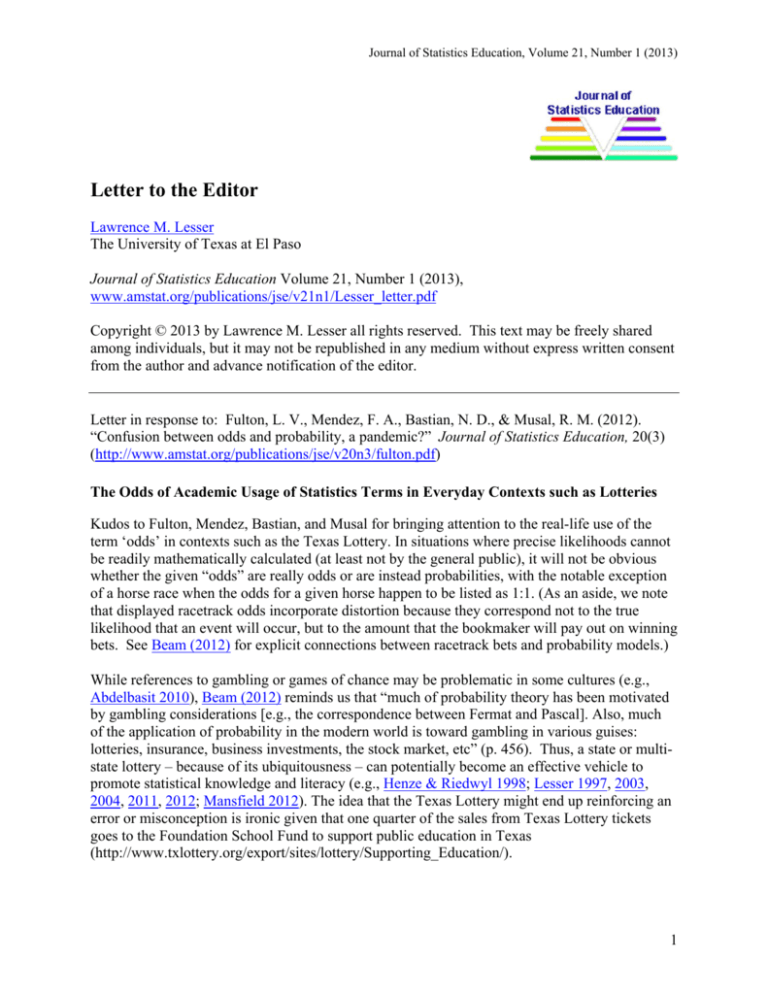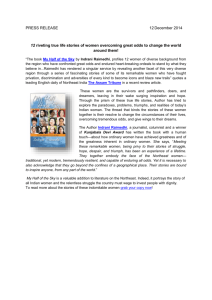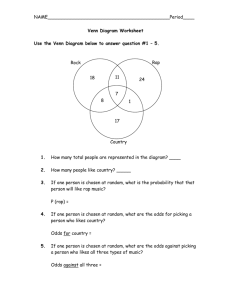
Journal of Statistics Education, Volume 21, Number 1 (2013)
Letter to the Editor
Lawrence M. Lesser
The University of Texas at El Paso
Journal of Statistics Education Volume 21, Number 1 (2013),
www.amstat.org/publications/jse/v21n1/Lesser_letter.pdf
Copyright © 2013 by Lawrence M. Lesser all rights reserved. This text may be freely shared
among individuals, but it may not be republished in any medium without express written consent
from the author and advance notification of the editor.
Letter in response to: Fulton, L. V., Mendez, F. A., Bastian, N. D., & Musal, R. M. (2012).
“Confusion between odds and probability, a pandemic?” Journal of Statistics Education, 20(3)
(http://www.amstat.org/publications/jse/v20n3/fulton.pdf)
The Odds of Academic Usage of Statistics Terms in Everyday Contexts such as Lotteries
Kudos to Fulton, Mendez, Bastian, and Musal for bringing attention to the real-life use of the
term ‘odds’ in contexts such as the Texas Lottery. In situations where precise likelihoods cannot
be readily mathematically calculated (at least not by the general public), it will not be obvious
whether the given “odds” are really odds or are instead probabilities, with the notable exception
of a horse race when the odds for a given horse happen to be listed as 1:1. (As an aside, we note
that displayed racetrack odds incorporate distortion because they correspond not to the true
likelihood that an event will occur, but to the amount that the bookmaker will pay out on winning
bets. See Beam (2012) for explicit connections between racetrack bets and probability models.)
While references to gambling or games of chance may be problematic in some cultures (e.g.,
Abdelbasit 2010), Beam (2012) reminds us that “much of probability theory has been motivated
by gambling considerations [e.g., the correspondence between Fermat and Pascal]. Also, much
of the application of probability in the modern world is toward gambling in various guises:
lotteries, insurance, business investments, the stock market, etc” (p. 456). Thus, a state or multistate lottery – because of its ubiquitousness – can potentially become an effective vehicle to
promote statistical knowledge and literacy (e.g., Henze & Riedwyl 1998; Lesser 1997, 2003,
2004, 2011, 2012; Mansfield 2012). The idea that the Texas Lottery might end up reinforcing an
error or misconception is ironic given that one quarter of the sales from Texas Lottery tickets
goes to the Foundation School Fund to support public education in Texas
(http://www.txlottery.org/export/sites/lottery/Supporting_Education/).
1
Journal of Statistics Education, Volume 21, Number 1 (2013)
That said, using the word “pandemic” in the article’s title may draw attention away from the fact
that there are statistical misconceptions regarding the lottery that are far more critical than “odds
versus probability.” The mathematical difference between 1/n and 1/(n + 1) for n >70 would
arguably be insufficient to influence how or if people play the lottery, but this is likely not the
case for a misunderstanding of terms such as “random” or “independent.”
The conflict between lay and academic uses of the word “random” is noted by ASA (2010) and
thoroughly explored by researchers (e.g., Fisher, Kaplan, & Rogness 2012; Kaplan, Fisher &
Rogness 2009, 2010; Kaplan, Rogness, & Fisher under review). If a person clings to interpreting
the word “random” in a slang everyday sense as meaning “haphazard,” “unexpected” or
“unusual,” then we can only wonder what such a person will make of this explanation the Texas
Lottery gives at
http://www.txlottery.org/export/sites/lottery/Games/Lotto_Texas/Pre-test_Results.html: “A pretest is an unofficial drawing that tests the machine and the ball set used for a Lotto Texas
drawing. Pre-tests ensure that the drawing machine is working well and that balls are drawn in a
random way.” Also, it appears that some players may choose their numbers under the influence
of a false belief that certain numbers or six-number sets have a different probability than others
because some numbers or sets of numbers are viewed as “less random” than others.
A component of the popular, everyday meaning of the word “independent” is the notion of
“separate” (e.g., a country declares itself to be an independent country with its own separate
territory), which is one reason why our students do not understand right away that disjoint
nonempty events can actually never be independent. So, simply telling a lottery player that each
drawing is independent may not force him/her to realize that the result of one drawing has no
effect on another. In other words, people may just falsely interpret independent drawings as
drawings that happen on separate occasions/days but not really believe that one drawing has no
effect on another. The latter idea may be evidenced by the huge hunger and commercial market
for so-called strategies such as tracking what numbers have been “hot” or “cold” and picking
their next lottery numbers accordingly, based on false beliefs in streaks or in the gambler’s
fallacy. Perhaps the Texas Lottery inadvertently partially enables this by posting
(http://www.txlottery.org/export/sites/lottery/Games/Lotto_Texas/Number_Frequency.html) how
many times each numbered ball has been drawn for more than six years’ worth of drawings.
And even though ticket holders have only 180 days to claim prizes, the Texas Lottery posts the
6-ball sets of winning numbers from well more than 180 days’ worth of drawings
(http://www.txlottery.org/export/sites/lottery/Games/Lotto_Texas/Winning_Numbers/).
In popular culture, the one-syllable (and therefore catchier?) words “chance” and “odds” are used
far more often than “probability” or “likelihood,” but usually only in situations that are referring
to likelihood in a generic manner rather than a specific numerical value. (Perhaps this is not
unlike how popular culture may more often use the word “average” in a generic way than in a
numerically precise way to invoke mean, median, or mode.) Examples of this range from hit
songs (e.g., Phil Collins’ #1 hit “Against All Odds” from the 1984 same-titled movie) to hit
movies or books (“may the odds be ever in your favor” is the tagline from The Hunger Games)
and even to the title of CPB/Annenberg’s excellent 26-video series on introductory statistics
(“Against All Odds”). We also note that there have been occasional books (e.g., Scammon
2
Journal of Statistics Education, Volume 21, Number 1 (2013)
1980) for general audiences that use “odds” in a sustained, consistent and correct manner,
including giving a correct explanation in the introduction.
There may be something to be gained by exploring why the word “odds” may be more persistent
or popular than “probability” in everyday contexts. For people without the confidence or training
to calculate precise probabilities, there may be something in the language of odds that better
reflects their feeling of a “rough estimate.” Compare the difference in perceived precision
between “the probability is .167” to “the odds are 5 to 1 against.” Also, the whole numbers that
generally make up odds offer concreteness: for 5:1 odds against, we can visualize drawing a ball
from a bucket that has 1 red ball and 5 black balls, or we can visualize winning $5 for every $1
we bet. This representation may have a great impact on how very small or very large likelihoods
are perceived: comparing a probability of 90% to 99% seems less dramatic than comparing 9:1
odds in favor of an event to 99:1 odds. Exposing students to different representations of
likelihood supports the Representation Standard of NCTM (2000).
The Texas Lottery may well be quite aware that their use of “odds” as a synonym for probability
is technically incorrect, but do so anyway by making at least one of the following assumptions:
(1) most players will not know the difference, (2) the numerical difference is negligible, (3) the
five-syllable word “probability” sounds more academic and therefore may appeal less readily to
the general public than the word “odds”, (4) some marketing strategy says the word choice will
increase sales, perhaps for reasons similar to why some companies use words (e.g., “pak,” “nite,”
“lite,” “krispie,” “kwik,” etc.) they know are misspelled.
Going beyond the specific context of lotteries, we should note that words like “odds,” “random,”
and “independent” are but three of dozens of words that can be used very differently in everyday
contexts than in academic statistics contexts. Whether framed as lexical ambiguity or movement
among linguistic registers, this area has seen many research papers (Kaplan, et al. 2009, 2010;
Lesser & Winsor 2009; Lesser, Wagler, Esquinca, & Valenzuela in press) and an invited session
at the 2012 Joint Statistical Meetings.
There is no harm in vying for everyday usage to conform to academic statistical usage, and the
battle that may be more within our immediate reach or means is to choose less ambiguous words
in our instruction and curriculum. Discrepancies that are inevitably encountered in the broader
world can (and should) be intentionally utilized by instructors as teachable moments, and
instructors also have the opportunity to make pedagogical choices during discussions. To that
end, we could keep our focus on the word ‘probability’ (not ‘odds’), in the same spirit as how
Kaplan, Rogness and Fisher (2012) make a convincing case for using the word ‘variability’
instead of ‘spread.’ In addition to avoiding the pitfalls already discussed, there are probably
reasons why introductory textbooks present rules of working with likelihoods in terms of
probability not odds. Probabilities cannot exceed 1; odds can. Probabilities of two
complementary events sum to 1; odds of two complementary events multiply to 1. Likelihoods
of conjunctive or disjunctive events have nice equations when expressed in probabilities, but not
when expressed with odds.
Rejoinder to this Letter to the Editor by Fulton, L. V., Mendez, F. A., Bastian, N. D., & Musal,
R. M. (2013) is available in the Journal of Statistics Education, 21(1)
3
Journal of Statistics Education, Volume 21, Number 1 (2013)
(http://www.amstat.org/publications/jse/v21n1/fulton_rejoinder.pdf)
References
Abdelbasit, K. M. (2010), “Teaching Statistics in a Language Other Than the Students’,” In C.
Reading (Ed.), Data and Context in Statistics Education: Towards an Evidence-Based Society.
Proceedings of the Eighth International Conference on Teaching Statistics. Voorburg, The
Netherlands: International Statistical Institute. Available online at
http://iase-web.org/documents/papers/icots8/ICOTS8_C215_ABDELBASIT.pdf.
American Statistical Association (2010), Guidelines for Assessment and Instruction in Statistics
Education: GAISE College Report. Available online at
http://www.amstat.org/education/gaise/GAISECollege.htm.
Beam, J. (2012), “What are the odds?,” PRIMUS: Problems, Resources, and Issues in
Mathematics Undergraduate Studies, 22(6), 451-457.
Fisher, D. G., Kaplan, J. J., & Rogness, N. T. (2012), “Helping Students Understand the
Meaning of Random: Addressing Lexical Ambiguity,” Webinar for the Consortium of the
Advancement of Undergraduate Statistics Education. Archived at:
http://www.causeweb.org/webinar/teaching/2010-08/.
Henze, N., & Riedwyl, H. (1998), How to Win More: Strategies for Increasing a Lottery Win.
Natick, MA: A.K. Peters.
Kaplan, J. J., Fisher, D. G., & Rogness, N. T. (2009), “Lexical Ambiguity in Statistics: What
do Students Know About the Words Association, Average, Confidence, Random and Spread?,”
Journal of Statistics Education, 17(3), 1-19. Available online at
http://www.amstat.org/publications/jse/v17n3/kaplan.pdf.
Kaplan, J. J., Fisher, D. G., & Rogness, N. T. (2010), “Lexical Ambiguity in Statistics: How
Students Use and Define the Words Association, Average, Confidence, Random and Spread,”
Journal of Statistics Education, 18(2), 1-22. Available online at
http://www.amstat.org/publications/jse/v18n2/kaplan.pdf.
Kaplan, J. J., Rogness, N. T., & Fisher, D. G. (2012), “Lexical Ambiguity: Making a Case
Against Spread,” Teaching Statistics, 34(2), 56-60.
Kaplan, J. J., Rogness, N. T., & Fisher, D. G. (under review), “Addressing the Lexical
Ambiguity Associated with Random.”
Lesser, L. (2012), “Lottery Lunacy [media clips],” Mathematics Teacher, 106(2), 93-94.
Lesser, L. (2011), “The Gambler: Teaching the Lottery-playing Public about Statistics.”
Available online at http://www.youtube.com/watch?v=PxGRghzr5zo.
4
Journal of Statistics Education, Volume 21, Number 1 (2013)
Lesser, L. (2004), “Take a Chance by Exploring the Statistics in Lotteries,” Statistics Teacher
Network, No. 65, 6-7. Available online at http://www.amstat.org/education/stn/pdfs/STN65.pdf.
Lesser, L. (2003), “A Whole Lotto Education!,” Texas Mathematics Teacher, 50(2), 12-15.
Available online at http://www.tctmonline.org/TMT_archive/TMT_2000s/TMT_2003_Fall.pdf.
Lesser, L. (1997), “Exploring Lotteries with Excel,” Spreadsheet User, 4(2), 4-7.
Lesser, L. & Winsor, M. (2009), “English Language Learners in Introductory Statistics: Lessons
Learned from an Exploratory Case Study of Two Pre-service Teachers,” Statistics Education
Research Journal, 8(2), 5-32. Available online at
http://iase-web.org/documents/SERJ/SERJ8(2)_Lesser_Winsor.pdf.
Lesser, L., Wagler, A., Esquinca, A., & Valenzuela, M. G. (in press), “Survey of Native English
Speakers and Spanish-speaking English Language Learners in Tertiary Introductory Statistics,”
Statistics Education Research Journal.
Mansfield, E. R. (2012), “Powerball: A Wealth of Data for a Variety of Student Projects,”
Proceedings of the 2012 Joint Statistical Meetings, Section on Statistical Education (pp. 27642772). Alexandria, VA: American Statistical Association.
National Council of Teachers of Mathematics (2000), Principles and Standards for School
Mathematics. Reston, VA: NCTM.
Scammon, R. M. (1980), The Odds on Virtually Everything. New York: G. P. Putnam’s Sons.
Lawrence M. Lesser
The University of Texas at El Paso
500 W. University Ave.
El Paso, TX 79968-0514
Lesser@utep.edu
Volume 21 (2013) | Archive | Index | Data Archive | Resources | Editorial Board | Guidelines for
Authors | Guidelines for Data Contributors | Guidelines for Readers/Data Users | Home Page |
Contact JSE | ASA Publications
5





